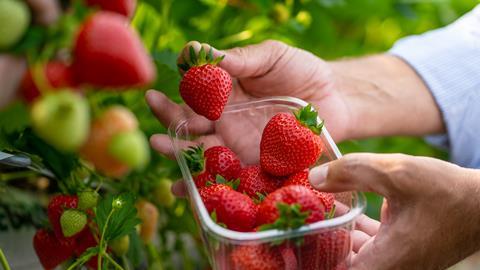Major UK suppliers estimate shortages of 10-20 per cent in July after hot June brings forward production, opening up a gap in supply during key sales period
The UK is facing a significant shortage of British strawberries during the peak sales period of Wimbledon fortnight following unseasonably hot weather in June.
High temperatures last month, which proved to be the hottest June on record, brought forward production and caused June-bearers to come to flush at the same time as everbearing and day-neutral varieties.
This meant volumes were above average last month, however the knock-on effect is that major suppliers have reported an estimated shortage of 10-20 per cent for July.
“There were lot of 1kg packs on the market in June to try to manage overall supply, which many retailers supported, but once the volume peaks it often results in a gap,” explained Peter Judge of S&A Produce. “As wise old growers say, you only pick them once! So we knew in advance that Wimbledon would be tight.”
Both S&A Produce (whose production is in Herefordshire, Kent, and South Wales) and Angus Soft Fruits (which grows berries on the east coast of Scotland, as well as in Evesham) said there would be considerably fewer British strawberries available than normal over the next few weeks.
Depending on the weather in July, the two suppliers expect volumes to return to normal levels in late July/early August.
“The warmer weather we’ve had over the last few weeks has accelerated some of the earlier crops and that’s pulled them forward a little bit, so a bit of a hole [in supply] has opened up,” explained Angus Soft Fruits MD John Gray, adding that above-average temperatures earlier in the season impacted the flowering of everbearers.
Fruit availability in April was considerably lower than in the spring of 2022 because of the colder weather, lower light levels, and the slow start to spring production, but volumes recovered in May and June when the sun came out and temperatures increased.
“The industry has had a reasonably good run over the last six weeks, and this is a bit of a blip,” Gray said.
“I think it shows that there aren’t as many British strawberries in production as is maybe perceived, and given the precarious grower economics, there is likely to be less British strawberry production in the future.”
Gray emphasised that strawberry availability is not as easy to predict as in many other fruits and vegetables, particularly since you can’t store strawberries for any length of time.
He added that increasingly volatile weather due to climate change is further challenging grower economics in the strawberry category.
That said, the Scot agreed with Judge that the 2023 strawberry harvest has so far been largely positive.
S&A’s group MD pointed out that, since the spring, weather has varied in different parts of the UK. Overall supply has therefore been “fairly stable” and of high quality, which has helped the crop to sell well.
Judge summarised that it had been a “positive” May and June, followed by some inevitable supply disruption in July, but said the question now is how hot it gets in July and August.
Meteorologists have warned of the possibility of a heatwave in the latter half of July or August. And that was certainly the case last year, with the UK experiencing its hottest day on record. Temperatures soared as high as 40.3°C in Coningsby, Lincolnshire on 19 July 2022.
“If it is too hot in early August, then growers will probably delay their planting of the June-bearers or overwinter strawberries until later in the month because they don’t want to plant into a heatwave. If this happens, the autumn crop may be delayed,” said Judge.
“Thermal events are ultimately unhelpful to strawberries, and if you get 10 days of 40°C heat, the berries are likely to go super small while some varieties will go into shock and stop growing for the year.”
Another industry source said that although it is a shame that the strawberry shortage has hit during Wimbledon fortnight, which is the biggest annual sales period for the fruit, the most important thing for suppliers is to manage retailers’ expectations.
If they promise a higher volume than they can ultimately deliver, there is the potential for reputational damage, he said.
“Although the market is short, it is about prioritisation. Anybody can supply when it’s easy, but when availability is tight it should be noted which customer supports which grower and which grower supports which customer. These are the key times that will define buying models and supply relationships going forward.”




